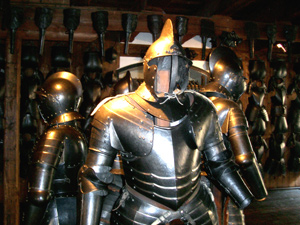Styrian Armoury on:
[Wikipedia]
[Google]
[Amazon]
 The Styrian Armoury (german: Landeszeughaus), in the Austrian city of
The Styrian Armoury (german: Landeszeughaus), in the Austrian city of  The armoury is situated in Graz's
The armoury is situated in Graz's
Unofficial site with a few flawsArmoury official site in english
{{Authority control Armories (military) Buildings and structures in Graz Military and war museums in Austria Museums in Graz Tourist attractions in Graz
Graz
Graz (; sl, Gradec) is the capital city of the Austrian state of Styria and second-largest city in Austria after Vienna. As of 1 January 2021, it had a population of 331,562 (294,236 of whom had principal-residence status). In 2018, the popu ...
, is the world's largest historic armoury
An arsenal is a place where arms and ammunition are made, maintained and repaired, stored, or issued, in any combination, whether privately or publicly owned. Arsenal and armoury (British English) or armory (American English) are mostly ...
and attracts visitors from all over the world. It holds approximately 32,000 pieces of weaponry, tools, suits of armour for battle and ones for parades.
Between the 15th century and the 18th century, Styria
Styria (german: Steiermark ; Serbo-Croatian and sl, ; hu, Stájerország) is a state (''Bundesland'') in the southeast of Austria. With an area of , Styria is the second largest state of Austria, after Lower Austria. Styria is bordered to ...
was on the front line of almost continuous conflict with the Ottoman Empire
The Ottoman Empire, * ; is an archaic version. The definite article forms and were synonymous * and el, Оθωμανική Αυτοκρατορία, Othōmanikē Avtokratoria, label=none * info page on book at Martin Luther University) ...
and with rebels in Hungary. In order to defend itself it needed troops and these troops needed equipment. The Styrian Armoury results from the resulting need to store large quantities of armour and weapons, and was built from 1642 - 1645 by a Tyrol
Tyrol (; historically the Tyrole; de-AT, Tirol ; it, Tirolo) is a historical region in the Alps - in Northern Italy and western Austria. The area was historically the core of the County of Tyrol, part of the Holy Roman Empire, Austrian Emp ...
ean architect called Antonio Solar
Antonio is a masculine given name of Etruscan origin deriving from the root name Antonius. It is a common name among Romance language-speaking populations as well as the Balkans and Lusophone Africa. It has been among the top 400 most popular ma ...
.
After about 100 years in use, Austrian empress Maria Theresia
Maria Theresa Walburga Amalia Christina (german: Maria Theresia; 13 May 1717 – 29 November 1780) was ruler of the Habsburg dominions from 1740 until her death in 1780, and the only woman to hold the position '' suo jure'' (in her own right) ...
wanted to close down the armoury, as part of her centralisation of the defence of Austria. Nevertheless, Styria petitioned for the ongoing existence of the armoury for both practical and sentimental reasons. Their petition was accepted and the Armoury was left intact, but largely decommissioned.
During World War II
World War II or the Second World War, often abbreviated as WWII or WW2, was a world war that lasted from 1939 to 1945. It involved the World War II by country, vast majority of the world's countries—including all of the great power ...
, the entire contents were moved to safety in three castles in remote parts of Styria, and no losses were recorded. After the end of the war, the objects were brought back into the undamaged original building.
 The armoury is situated in Graz's
The armoury is situated in Graz's Inner City
The term ''inner city'' has been used, especially in the United States, as a euphemism for majority-minority lower-income residential districts that often refer to rundown neighborhoods, in a downtown or city centre area. Sociologists somet ...
, a few steps from Hauptplatz at Herrengasse Nr. 16. The armoury is open six days a week, closed Mondays, throughout the year. In November, it can only be visited through guided tours.
References
External links
*Unofficial site with a few flaws
{{Authority control Armories (military) Buildings and structures in Graz Military and war museums in Austria Museums in Graz Tourist attractions in Graz